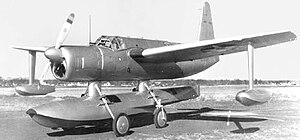Vought XSO2U
| XSO2U-1 | |
|---|---|

| |
| Role | Observation floatplane |
| National origin | United States |
| Manufacturer | Vought-Sikorsky
|
| First flight | July 1939 |
| Retired | July 1944 |
| Primary user | United States Navy |
| Number built | 1 |
| Developed from | OS2U Kingfisher
|
The Vought XSO2U was an American observation
Design and development
In the late 1930s the United States Navy developed a set of specifications for a new scout-observation aircraft to operate from its
Designs were submitted in response to the Navy's specifications by
Capable of being operated with either the float as a seaplane or with a conventional
The aircraft was capable of performing
Operational history
Assigned the
The aircraft also suffered from engine problems, however, that were not so easily cured; the Ranger engine was well known for unreliability, and was particularly prone to overheating problems that were never satisfactorily solved. The aircraft's original XV-770-4 engine was replaced by a XV-770-6, with a repositioned oil cooler, during flight testing; despite this, the problems continued.[1]
Despite the engine issues, the SO2U-1 was considered overall to be superior to the competing
Following the end of the
Operators
Specifications (XSO2U-1)

Data from OS2U Kingfisher in action[1]
General characteristics
- Crew: 2 (pilot and observer)
- Length: 36 ft 1 in (11.00 m)
- Wingspan: 38 ft 2 in (11.63 m)
- Height: 15 ft 11 in (4.85 m)
- Wing area: 300 sq ft (28 m2)
- Empty weight: 4,016 lb (1,822 kg)
- Max takeoff weight: 5,624 lb (2,551 kg)
- Fuel capacity: 128 US gallons (480 L; 107 imp gal)
- Powerplant: 1 × inline engine, 450 hp (340 kW)
- Propellers: 2-bladed Hamilton Standard constant-speed
Performance
- Maximum speed: 190 mph (310 km/h, 170 kn) at 9,000 feet (2,700 m)
- Service ceiling: 22,200 ft (6,800 m)
Armament
- Guns: 2 x M2 Browning machine guns, one fixed forwards-firing, one flexible rear-firing.
- Bombs: Two light bombs or depth charges on underwing racks.
See also
Aircraft of comparable role, configuration, and era
- Curtiss SOC Seagull
- Curtiss SO3C Seagull
- Vought OS2U Kingfisher
Related lists
References
Citations
Bibliography
- Adcock, Al (1991). OS2U Kingfisher in action. Aircraft In Action. Vol. 119. Carrollton, TX: Squadron/Signal Publications. ISBN 0-89747-270-5.
- Baugher, Joe (September 18, 2010). "US Navy and US Marine Corps BuNos, Second Series (0001 to 5029)". US Navy and US Marine Corps Aircraft Serial Numbers and Bureau Numbers--1911 to Present. Retrieved 2011-01-12.
- Bowers, Peter M. (1979). Curtiss Aircraft, 1907-1947. New York: Putnam. ISBN 978-0-370-10029-6.
- ASIN B0000CLL8R.
- Polmar, Norman (2004). Historic Naval Aircraft: from the pages of Naval History Magazine. Dulles, VA: Brassey's Inc. ISBN 1-57488-572-3.
